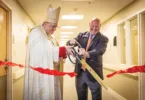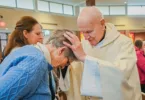by Joe Bollig
joe.bollig@theleaven.org
KANSAS CITY, Kan. — Members of Holy Name Church here celebrated the 100th anniversary of their parish on Jan. 4 with an enduring mystery.
Namely, what happened to the towers?
Construction of the limestone, Romanesque church began when the cornerstone was laid on May 2, 1909. The finished church was dedicated on June 2, 1912.
And here’s where the mystery comes in.
An article in the German-language newspaper “Amerika,” published in St. Louis, contained an article about “Die neue Kirche zum hl. Namen in Rosedale” on the occasion of its dedication.
The article was accompanied by a picture of Holy Name Church that is nearly identical to the present structure, except for “two tall, steeply roofed towers with ornate belfries,” according to a 2001 parish history.
Clearly, the original plans called for two taller Romanesque belfries, not the two existing squat, peaked roofs.
Did the pastor back then, Father Anthony Dornseifer, try to hustle the project along by cutting out the towers? Did the parish run out of money? Or was it simply a matter of individual taste?
Surviving records don’t give a clue. The shape of the towers was of no concern to parishioners, however, when they celebrated the feast day of the Holy Name of Jesus on Jan. 3, and then the centennial of the church the next day. Father Jerry Spencer, the pastor, used “creative scheduling” so the centennial date and the feast day could be observed on the same weekend.
Archbishop Joseph F. Naumann was the main celebrant and homilist of the Jan. 4 centennial Mass, with Father Spencer as concelebrant. The Mass was followed by a lunch in the school hall. A video of the parish’s history was played during the lunch.
A 2001 parish history records that the origin of Holy Name began when an Irish settler, Richard Fitzgerald, purchased land in the Turkey Creek Valley from Big Knife, a member of the Wyandot tribe.
Fitzgerald built a log cabin on a plot located northwest of the present church, between Turkey Creek and the St. Louis and San Francisco Railroad tracks. Fitzgerald’s land was surrounded by trees, hazel brush, and wild roses, the latter providing the name for the future community of Rosedale.
Fitzgerald survived the “Bleeding Kansas” era and the Civil War. Immigrants began to populate the area, and his cabin became the site of the first Mass in the community, celebrated in 1874, by Father Anton Kuhls, pastor of St. Mary Church in Kansas City, Kan.
As the community of Rosedale gradually industrialized, the rural character of the area began to fall away. A wood-frame church dedicated to the Holy Name of Jesus was built in 1876 and operated as a mission of St. Joseph Parish in Gum Springs — now known as Shawnee. Little Holy Name Mission was the third Catholic church in Wyandotte County.
“We had a mix of people,” said Father Spencer. “There were Germans, Irish, Belgians and Hungarians from the late 1800s on, and through the years we had a mix of other peoples, including African-Americans and Orientals.”
Rosedale was eventually incorporated by the city of Kansas City, Kan., and the church continued to grow as more diverse peoples moved to this neighborhood. By 1912, a significant number of Mexican immigrants had settled there. Today, the parish is largely Hispanic.
The community has been defined, in large part, by the influx of Hispanic families and the decline of the railroads, once the lifeblood of the area. The 1970s and 1980s were a period of particular decline.
But the scrappy immigrant parish never gave up, even as businesses closed and the neighborhood changed. Energetic pastors led efforts to keep the parish vital.
One of those pastors was Father Spencer, who has led the 350-family parish since July 22, 1986. In addition to his pastoral work, he is a hospital chaplain at the nearby University of Kansas Medical Center.
“As far as the future of Holy Name, it’s hard to say with all the changes in Wyandotte County,” said Father Spencer.
“We’ve been a part of the Wyandotte County Pastoral Planning process. And at one time it was suggested that our school merge with Our Lady of Unity,” he said, “but that’s not practical at this time.
“Just now, we’re staying put and holding forth.”






